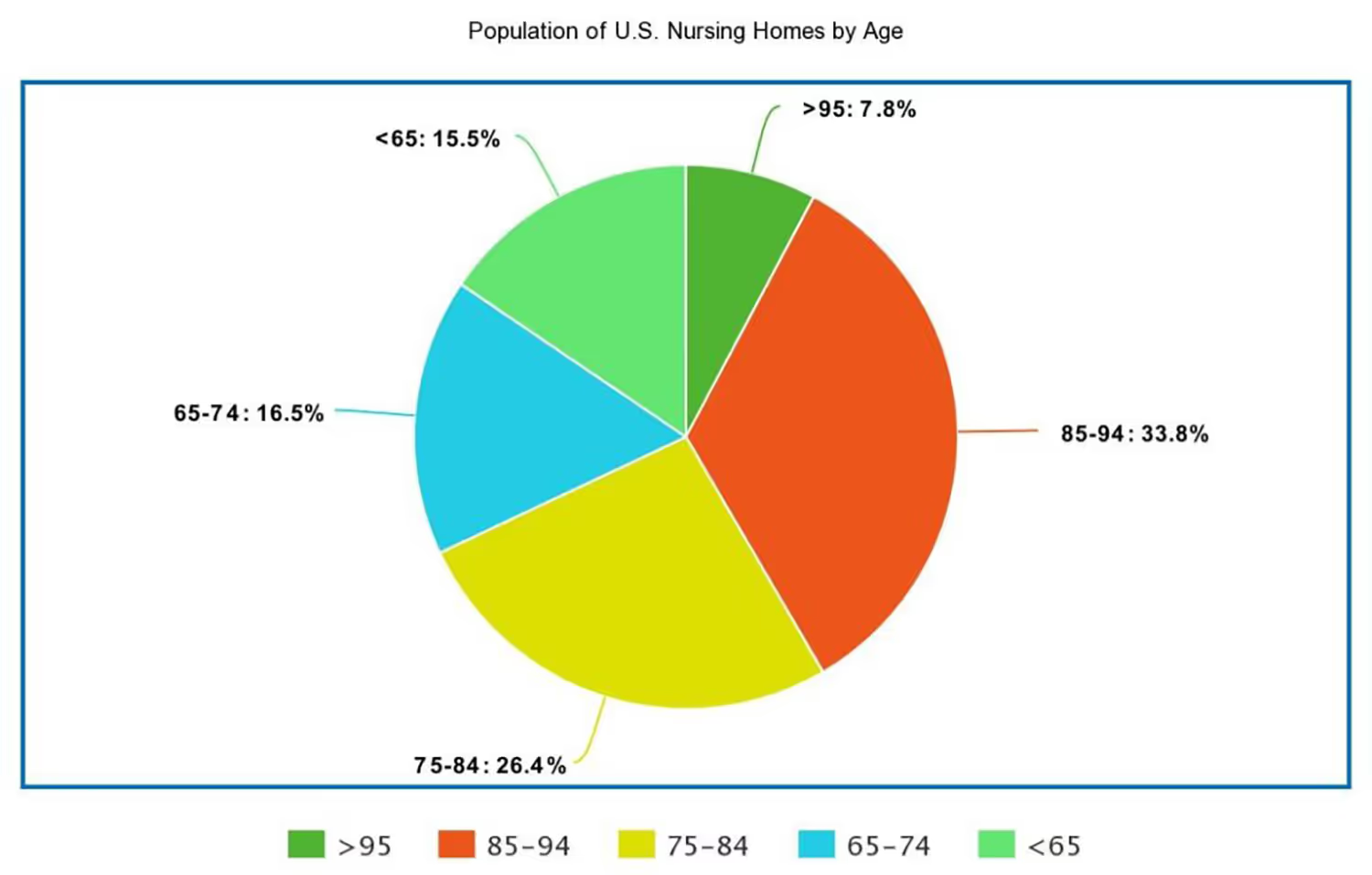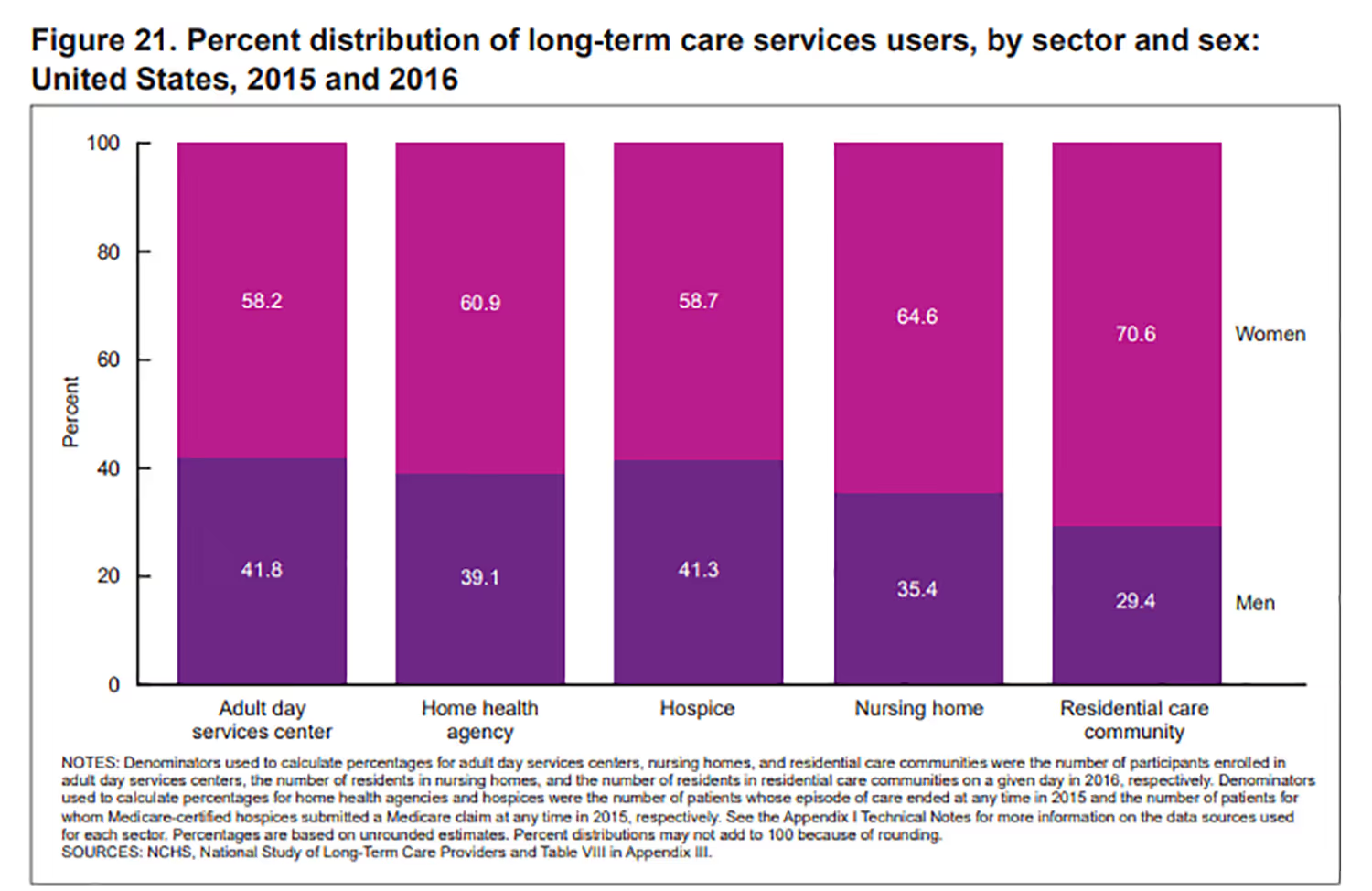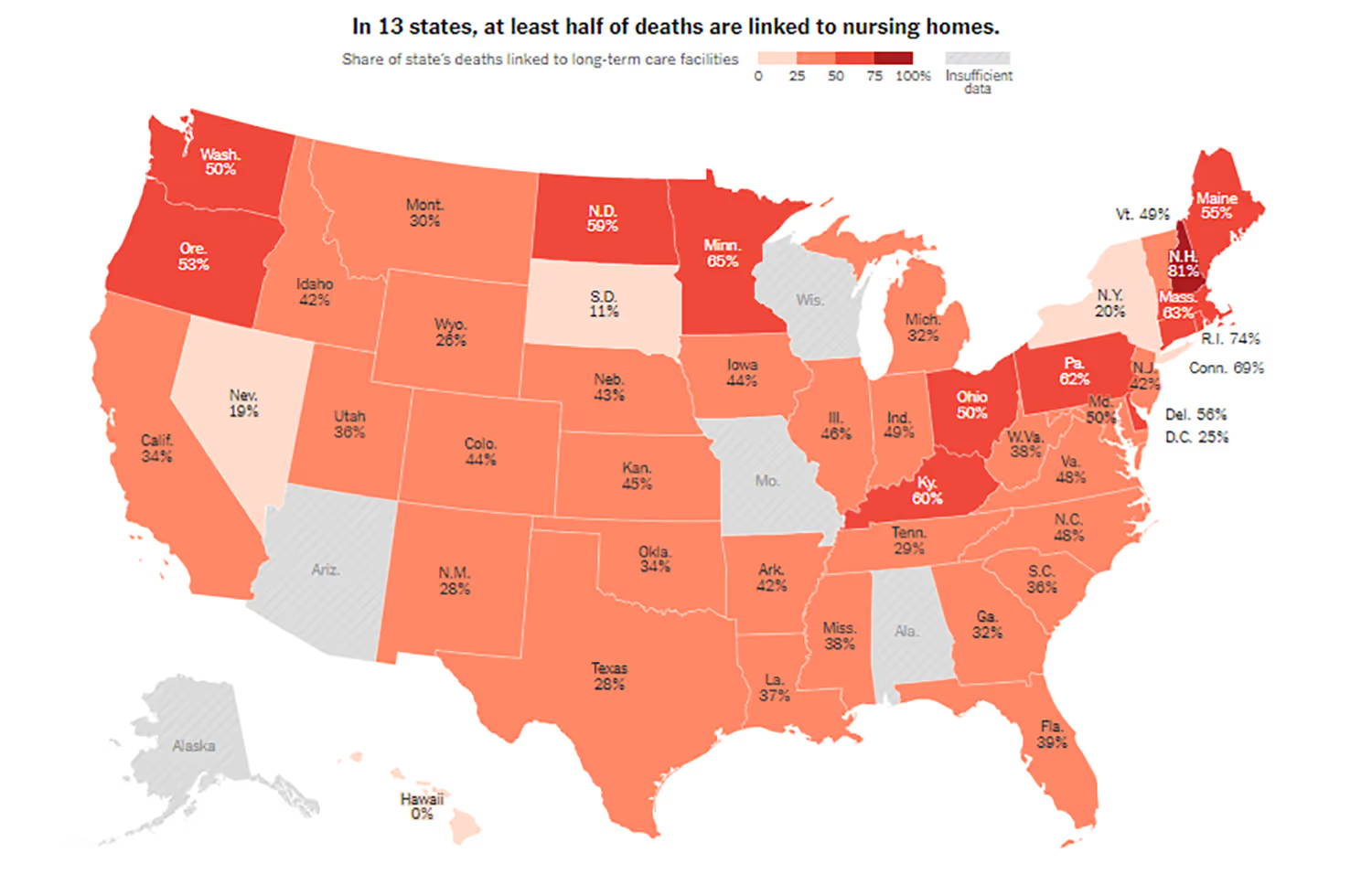40 Need to Know Nursing Home Statistics
Here are 40 nursing home statistics to give you a better idea of the factors that impact facilities and their residents.

As people get older, thinking about new living options isn’t out of the question. It may not be as easy to get around the house as it used to be, or they may have health concerns that they can’t manage on their own.
When you think of care for the elderly, nursing homes probably come to mind. These are the second-most used long-term care facility, right after assisted living. Residents receive more attention in a nursing home since they are less independent in their old age.
As more Baby Boomers (the second-largest generation) reach retirement age, more people need extended care.

Different factors contribute to who uses these services. For those who do, they may face new challenges such as financial burdens or new health problems.
Here are 40 nursing home statistics to give you a better idea of the factors that impact facilities and their residents.
Facilities Across The Country
There are many different long-term care options, but nursing homes are the most well-known. These facilities exist across the country, but certain states have more or less depending on demographics.
With an increasingly older population, the number of residents will continue to grow. Enough services are necessary to accommodate them, but unfortunately, facility numbers are shrinking. Some older people even have to be caregivers themselves.
As nursing homes are closing, there is also a decreasing number of residents despite an aging population. This could suggest that older people are not receiving the care that they need. Facility closures will be problematic as more people reach the stage of requiring care.
- As of 2016, the following facilities were providing long-term services (CDC):
- 4,600 adult day service centers
- 12,200 home health agencies
- 4,300 hospices
- 15,600 nursing homes
- 28,900 assisted living and similar residential care communities
- As of 2019, there were 1,246,079 nursing facility residents in the US. (Kaiser Family Foundation)
- California had the most at 99,956, and Alaska has the least at 499. (Kaiser Family Foundation)

- More than 80% of residents need help with at least three activities of daily living (ADLs) such as dressing or bathing. Around 90% who can walk require assistance or supervision. (HealthinAging.org)
- 14% of caregivers for older adults are at least age 65 themselves. (LongTermCare.gov)
- Over 550 nursing homes have closed since June 2015. But occupancy has decreased by almost two percentage points despite the closures. (LeadingAge)
Resident Demographics
When we think of nursing homes, we imagine patients who are elderly and frail. But these aren’t the only people living at these centers.
People who have reached retirement age have a high chance of needing care even though they may still seem young compared to other patients. Even people under the retirement age utilize these facilities, either temporarily or permanently.
Because women have a longer life expectancy than men, they make up a majority of these homes. The longer they live, the more likely they are to require care.

- People over 65 now have almost a 70% chance of needing some form of long-term care. (LongTermCare.gov)
- More than 40% of nursing home patients are over the age of 85. (Nursing Home Abuse Center)
- 16.5% are under age 65. These people often just need rehabilitation, not care for their whole lives. (US News)
- 8% of people between ages 40 to 50 have a disability that may require long-term care. (LongTermCare.gov)
- Women make up almost 65% of nursing home residents. (CDC)

- There are even more women as age increases… (National Library of Medicine)
- Ages 65-74: 132 women for every 100 men
- 75-84: 246 women for every 100 men
- 85+: 425 women for every 100 men
- Of those over the age of 75, women are 60% more likely than men to need help with at least one activity of daily living. (American Association for Long-Term Care Insurance)
Family Dynamics
The family plays a role in older peoples’ care needs. Singleness can contribute to poorer emotional and physical health. Without a companion or someone to help look after them, more single people end up in senior care.
Having more children can also reduce the need for a professional care setting. Children help take care of their parents instead of finding them a long-term care facility. But unfortunately, older people are starting to outnumber children. This trend will continue as the current fertility rate is less than the number of children needed to replace the population.
- Almost 70% of residents don’t have a spouse (widowed, divorced, or never married). (HealthinAging)
- Additional children reduces a womans risk of nursing home use by 6%. (NCBI)
Financial Coverage
Housing can be a financial burden to anyone. Nursing homes are even more costly than typical housing since they include professional staff and services.

Now combine this with a retirement budget. This makes for an expensive bill. While there are some coverage options, most residents will be paying part out of pocket. And unfortunately, most of them don’t plan for it with their savings.
- Around 21% of Medicaid spending was for long-term care. (Kaiser Family Foundation)
- When staying in a nursing home for a maximum of 100 days, the average Medicare-covered stay is 22 days. (LongTermCare.gov)
- 56% of middle-income Baby Boomers mistakenly think that Medicare will pay for ongoing long-term care. (BankersLife)
- 79% of Baby Boomers have no money set aside for long-term care services. (BankersLife)
- The current average cost per year is $93,075 for a semi-private room and $105,850 for a private room. This will likely increase by several thousand dollars in 2021. (Genworth)

Conditions and Health Problems
Getting older is usually associated with declining health. People are less active, become weak, have more risk for illness, and experience declining memory.
Because they experience more health conditions, older people have a higher chance of needing long-term care. It’s difficult to manage these conditions on their own. But even in nursing homes, they don’t always receive the necessary services or care. And being near other sick patients can increase their chance of getting sick.
- As of 2016, 47.8% of nursing home patients had Alzheimer’s or other dementias. (CDC)
- 33% of people over 70 have bilateral hearing loss (hearing loss in both ears). 75% have hearing loss in at least one ear. But as low as 9% wear hearing aids. (The Hearing Journal)
- A nursing home with 100 residents reports around 100 to 200 falls in an average year.
- Around 1,800 patients die from falls each year. (Nursing Home Abuse Center)
- Of 1.6 million US nursing home residents, around half fall each year. About 1 in 3 who do fall will fall twice or more. One in every 10 residents who falls has a serious related injury, including around 65,000 patients with hip fractures. (Agency for Healthcare Research and Quality)
- At least 101,000 COVID-19 deaths have been from long-term care facilities. There have been more than 724,000 cases at over 27,000 facilities. Nursing homes only account for 6% of all US cases, but 39% of the deaths. (The New York Times)

Conclusion
Long-term care services can be great for aging patients, especially those who live alone or have chronic health conditions. As the older population grows, one would assume that nursing homes are filling up.
But that isn’t necessarily the case. Even with people living longer, facilities are closing and fewer people use them. It isn’t because adults experience fewer health conditions. There are actually many younger residents who also need care.
However, the cost is increasing and a majority of the retiring generation didn’t plan for these expenses. There’s a common misconception that Medicare will cover all expenses, but most people need to pay out-of-pocket costs.
For those who do afford to receive care, the services aren’t perfect. Being close together to other ill patients can mean disease spread. And even with assistance and supervision, falls are still likely resulting in injuries that can be fatal.
As more people get older, nursing homes need to stay open to accommodate them. Financial help may be necessary especially for those who don’t have family members to care for them. Once patients arrive, they need even more attention because they will only continue to age and may decline.
Emphasize your product's unique features or benefits to differentiate it from competitors
In nec dictum adipiscing pharetra enim etiam scelerisque dolor purus ipsum egestas cursus vulputate arcu egestas ut eu sed mollis consectetur mattis pharetra curabitur et maecenas in mattis fames consectetur ipsum quis risus mauris aliquam ornare nisl purus at ipsum nulla accumsan consectetur vestibulum suspendisse aliquam condimentum scelerisque lacinia pellentesque vestibulum condimentum turpis ligula pharetra dictum sapien facilisis sapien at sagittis et cursus congue.
- Pharetra curabitur et maecenas in mattis fames consectetur ipsum quis risus.
- Justo urna nisi auctor consequat consectetur dolor lectus blandit.
- Eget egestas volutpat lacinia vestibulum vitae mattis hendrerit.
- Ornare elit odio tellus orci bibendum dictum id sem congue enim amet diam.
Incorporate statistics or specific numbers to highlight the effectiveness or popularity of your offering
Convallis pellentesque ullamcorper sapien sed tristique fermentum proin amet quam tincidunt feugiat vitae neque quisque odio ut pellentesque ac mauris eget lectus. Pretium arcu turpis lacus sapien sit at eu sapien duis magna nunc nibh nam non ut nibh ultrices ultrices elementum egestas enim nisl sed cursus pellentesque sit dignissim enim euismod sit et convallis sed pelis viverra quam at nisl sit pharetra enim nisl nec vestibulum posuere in volutpat sed blandit neque risus.

Use time-sensitive language to encourage immediate action, such as "Limited Time Offer
Feugiat vitae neque quisque odio ut pellentesque ac mauris eget lectus. Pretium arcu turpis lacus sapien sit at eu sapien duis magna nunc nibh nam non ut nibh ultrices ultrices elementum egestas enim nisl sed cursus pellentesque sit dignissim enim euismod sit et convallis sed pelis viverra quam at nisl sit pharetra enim nisl nec vestibulum posuere in volutpat sed blandit neque risus.
- Pharetra curabitur et maecenas in mattis fames consectetur ipsum quis risus.
- Justo urna nisi auctor consequat consectetur dolor lectus blandit.
- Eget egestas volutpat lacinia vestibulum vitae mattis hendrerit.
- Ornare elit odio tellus orci bibendum dictum id sem congue enim amet diam.
Address customer pain points directly by showing how your product solves their problems
Feugiat vitae neque quisque odio ut pellentesque ac mauris eget lectus. Pretium arcu turpis lacus sapien sit at eu sapien duis magna nunc nibh nam non ut nibh ultrices ultrices elementum egestas enim nisl sed cursus pellentesque sit dignissim enim euismod sit et convallis sed pelis viverra quam at nisl sit pharetra enim nisl nec vestibulum posuere in volutpat sed blandit neque risus.
Vel etiam vel amet aenean eget in habitasse nunc duis tellus sem turpis risus aliquam ac volutpat tellus eu faucibus ullamcorper.
Tailor titles to your ideal customer segment using phrases like "Designed for Busy Professionals
Sed pretium id nibh id sit felis vitae volutpat volutpat adipiscing at sodales neque lectus mi phasellus commodo at elit suspendisse ornare faucibus lectus purus viverra in nec aliquet commodo et sed sed nisi tempor mi pellentesque arcu viverra pretium duis enim vulputate dignissim etiam ultrices vitae neque urna proin nibh diam turpis augue lacus.


.avif)

